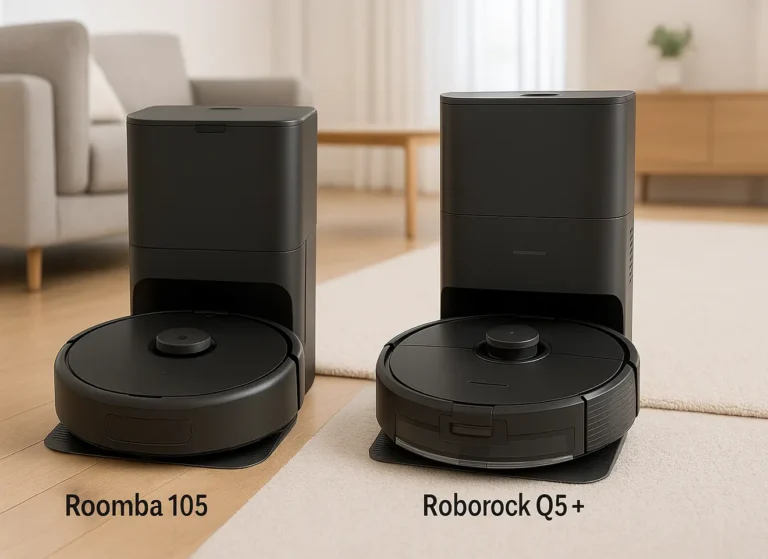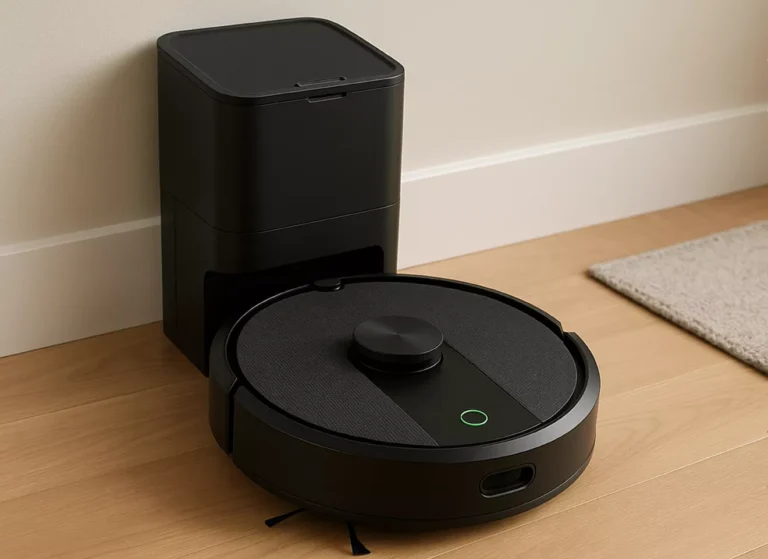How to Set Up Your First Smart Home: A Beginner's Guide [With Setup Checklist]
![How To Set Up Your First Smart Home: A Beginner'S Guide [With Setup Checklist] 1 Smart home setup](https://easysmarthomeguide.com/wp-content/uploads/2025/07/portada-ben-1-1024x450.webp)
![How To Set Up Your First Smart Home: A Beginner'S Guide [With Setup Checklist] 2 Smart home setup](https://easysmarthomeguide.com/wp-content/uploads/2025/07/portada-ben-1-1-1024x768.webp)
Did you know that a smart home beginner can save up to 10-12% on heating and about 15% on cooling costs annually with just a smart thermostat?
Imagine walking into your home, having the lights turn on automatically, and asking your virtual assistant to make you a cup of coffee—all with minimal setup and technical knowledge. This isn’t science fiction; it’s what modern smart home technology offers today. Additionally, smart thermostats and LED light bulbs can adjust to your habits and preferences, reducing unnecessary energy consumption.
However, for many people, the idea of setting up a smart home seems overwhelming. With devices ranging from $15 smart bulbs to $150 smart locks and $130 thermostats , knowing where to start can be intimidating. Fortunately, getting started doesn’t require turning your entire house into a technological showcase overnight.
In this article, you’ll discover a straightforward approach to setting up your first smart home. We’ll walk through everything from planning your setup to choosing the right devices and creating simple automations—all without requiring you to become a tech expert. This smart home guide is specifically designed for beginners who want the benefits of connected living without the complexity.
Let’s start by planning your smart home setup, so you can enjoy convenience, energy savings, and a touch of the future in your everyday life.
Plan Your Smart Home Setup
Before purchasing any smart devices, taking time to plan your smart home setup is crucial for both short-term satisfaction and long-term expansion. A thoughtful approach ensures your investment aligns with your needs and works seamlessly in your living space.
Define your goals and priorities
Begin by identifying exactly what you want to achieve with your smart home technology. Are you primarily focused on enhancing security, improving energy efficiency, adding convenience, or enhancing entertainment? The objectives you establish will guide your device choices throughout the process [1].
For many homeowners, energy and cost savings are major motivators, while others prioritize comfort and convenience through automation of daily routines [2]. Consequently, your unique needs should determine which rooms and functions to automate first.
Furthermore, consider family members with special needs—smart homes with integrated assisted living technology can enable elderly or disabled family members to live more independently and securely [2].
Set a realistic budget
According to the Energy Star program, the on energy costs average homeowner spends around USD 2000 per year[3]. Smart home devices offer potential savings, yet require initial investment. The current average cost of smart home automation technology is USD 676 and can range up to USD 15000 or more [4]!
Therefore, create a budget covering both initial device costs and ongoing expenses like subscription services or cloud storage. Importantly, set aside about 10-20% of your budget for unforeseen costs [5].
Remember that building a smart home is a marathon, not a sprint [6]. Start with a few essential devices that address your primary needs, then gradually expand your system over time as your budget allows.
Decide between smart hub or standalone devices
For beginners, the question of whether to use a smart hub or standalone devices depends largely on your plans and technical comfort level.
If you’re new to smart home technology—especially if you’re somewhat tech-averse—consider the “baby-step approach” with standalone devices [7]. make excellent starter products since they’re relatively inexpensive and offer immediate benefits Doorbell cameras (USD 100-300)[7].
Alternatively, if you plan to connect more than a handful of devices, a hub streamlines control through a single smartphone app [7]. Options include Samsung SmartThings (USD 80) or Wink Hub (USD 70) [7].
For those seeking simplicity, smart speakers like Amazon Echo or Google Home increasingly function as control hubs while being more affordable than dedicated hubs [8].
Choose and Install Your First Smart Devices
![How To Set Up Your First Smart Home: A Beginner'S Guide [With Setup Checklist] 3 Smart home setup](https://easysmarthomeguide.com/wp-content/uploads/2025/07/imagen-2-be-2-1024x450.webp)
![How To Set Up Your First Smart Home: A Beginner'S Guide [With Setup Checklist] 4 Smart home setup](https://easysmarthomeguide.com/wp-content/uploads/2025/07/imagen-2-be-2-1-1024x768.webp)
Image Source: Handyman Austin
Once your plan is in place, it’s time to select and install your first smart devices. Starting with simple, high-impact products will help you build confidence as you begin your smart home journey.
Smart lights for easy control
Smart LED bulbs provide an instant way to transform any room’s ambiance. They offer brightness control, color-changing capabilities, and can be operated remotely—all without installing new switches [9]. Most smart bulbs connect via Wi-Fi or Bluetooth, though some require a separate hub like the Philips Hue Bridge [10]. Installation is remarkably straightforward—simply screw in the bulb and pair it with your smartphone app. For beginners, the AiDot Linkind Wi-Fi Matter Smart Light Bulb offers 16 million colors and works with all major smart home platforms [11].
Smart locks for better security
Smart locks enhance home security while eliminating the need for physical keys. and requires only a screwdriver Installation typically takes under 15 minutes[12]. The process involves removing your existing deadbolt, inserting the new smart lock’s deadbolt, and attaching the exterior and interior components [12]. For a beginner-friendly option, consider the Ultraloq Bolt Fingerprint, which offers multiple entry methods including fingerprint, keypad, mobile app, and traditional keys [11].
Smart thermostats for comfort and savings
A smart thermostat automatically adjusts your home’s temperature for optimal comfort and efficiency. In fact, the average American household spends nearly $900 annually on heating and cooling [13]. Installing one can save 10-15% on heating and cooling costs[14]. Most models like the Ecobee Smart Thermostat Premium include features such as remote control via smartphone, geofencing to detect when you’re away, and learning capabilities that adapt to your preferences [13][15].
Smart plugs to upgrade old devices
Smart plugs transform ordinary appliances into connected devices without replacing them. Notably, the TP-Link Kasa Smart Wi-Fi Plug Slim offers robust features including energy monitoring and scheduling [16]. Use them to:
- Automate coffee makers, lamps, and fans
- Monitor power usage of energy-hungry appliances
- Set up “Away Mode” to deter potential intruders by randomly turning devices on and off [16]
As you install each device, remember to place Wi-Fi-connected products within good range of your router to ensure reliable performance [17].
Build a Reliable Smart Home Network
![How To Set Up Your First Smart Home: A Beginner'S Guide [With Setup Checklist] 5 Smart home setup](https://easysmarthomeguide.com/wp-content/uploads/2025/07/imagen-3-be-3-1024x450.webp)
![How To Set Up Your First Smart Home: A Beginner'S Guide [With Setup Checklist] 6 Imagen 3 be 3 1 smart home setup](https://easysmarthomeguide.com/wp-content/uploads/2025/07/imagen-3-be-3-1-1024x768.webp)
Image Source: Reolink
A robust network forms the foundation of every successful smart home setup. Without reliable connectivity, even the most advanced devices can become frustrating paperweights.
Check your Wi-Fi coverage
First and foremost, position your router strategically—centrally located, elevated, and away from obstructions. Rather than hiding it in a cabinet, place it in open air to prevent interference and overheating [18]. Test your connection throughout your home by connecting devices in different rooms. If speeds drop significantly in certain areas, you may have coverage issues. Common signal blockers include concrete walls, large metal furniture, mirrors with metallic coating, and refrigerators [19].
Consider a mesh system for large homes
For or buildings with signal-killing walls (brick, stucco, concrete), a single router often struggles to provide consistent coverage homes larger than 2,300 square feet[2]. Mesh networks place multiple access points throughout your home, creating seamless coverage. Moreover, they automatically route traffic through the fastest path, reducing lag in your smart home commands [2]. Budget-friendly options include the Netgear Orbi AC1200 three-pack ($129) [1], whereas the offers excellent performance for most homes Eero 6 Plus three-piece system ($300)[1].
Secure your network with strong passwords
Out-of-box routers typically use default credentials easily found online by hackers [20]. As a result, changing these settings should be your immediate priority. Create a unique, complex Wi-Fi password at least 15 characters long [21]. Use WPA3 encryption when available, or at minimum WPA2 [20]. Finally, keep your router’s firmware updated to protect against vulnerabilities [21].
Expand and Automate Your Smart Home
![How To Set Up Your First Smart Home: A Beginner'S Guide [With Setup Checklist] 7 Smart home setup](https://easysmarthomeguide.com/wp-content/uploads/2025/07/imagen-4-be-4-1024x450.webp)
![How To Set Up Your First Smart Home: A Beginner'S Guide [With Setup Checklist] 8 Imagen 4 be 4 1 smart home setup](https://easysmarthomeguide.com/wp-content/uploads/2025/07/imagen-4-be-4-1-1024x768.webp)
Image Source: The Verge
The true magic of a smart home happens when your devices work together automatically. After setting up your basic devices, it’s time to make them truly “smart” through automation.
Use voice assistants for hands-free control
Voice assistants transform how you interact with your home. own smart speakers, with that number projected to reach 55% by 2022 Over a quarter of US adults[22]. Choose between Google Assistant (most widely used), Amazon Alexa, or Apple’s Siri (supports 21 different languages) [6]. These assistants let you control lights, adjust thermostats, and lock doors hands-free [3]. They’re particularly valuable when cooking, carrying groceries, or helping those with mobility challenges [22].
Create routines and schedules
Instead of controlling devices individually, create routines that trigger multiple actions at once. For example, a “Good Morning” routine could:
- Turn on lights
- Adjust thermostat
- Brew coffee
- Read your calendar events [5]
You can also set up location-based automations that detect when you’re approaching home to disarm security systems and turn on entry lights [23].
Ensure device compatibility for future upgrades
Before adding new devices, check compatibility with your existing ecosystem. Consider using IFTTT (If This Then That) to connect devices that don’t naturally communicate [24]. For long-term flexibility, look for products supporting universal standards like Z-Wave or Zigbee [25]. Also, keep all devices regularly updated with the latest firmware to maintain compatibility and security [26].
Conclusion
Setting up your first smart home doesn’t need to feel overwhelming or technically complex. Instead, you can approach this journey step by step, starting with devices that offer immediate benefits while planning for future expansion.
Your smart home should reflect your specific needs and lifestyle rather than following someone else’s blueprint. Therefore, take time to identify your priorities before purchasing any devices. Whether you aim to boost security, save energy, or add convenience, these goals will guide your entire setup process.
Budget considerations certainly play an important role when building your smart home ecosystem. Fortunately, you can begin with affordable options like smart plugs or bulbs, then gradually expand as your comfort level and budget allow. Additionally, starting with standalone devices before committing to a hub-based system gives you flexibility while learning.
Network reliability undoubtedly forms the foundation of any successful smart home. Without strong Wi-Fi coverage throughout your living space, even the most sophisticated devices will fail to perform consistently. Thus, investing in proper network infrastructure early will prevent frustration later.
The true power of smart home technology comes alive when your devices work together seamlessly. Consequently, creating simple automations and routines transforms individual gadgets into a cohesive system that anticipates your needs. Voice assistants further enhance this experience by allowing hands-free control throughout your home.
Above all, remember that building a smart home resembles a marathon rather than a sprint. You can enjoy the benefits of automation right away with just a few devices while developing your system over time. Soon enough, you’ll wonder how you ever lived without lights that respond to your voice, a thermostat that knows your schedule, and locks that secure your home remotely. Your journey toward a more connected, efficient living space starts with these simple steps.
Key Takeaways
Transform your home into a smart, efficient space with these essential insights for beginners looking to embrace connected living technology.
- Start with clear goals and realistic budgets—define whether you prioritize security, energy savings, or convenience before purchasing devices
- Begin with simple, high-impact devices like smart bulbs, plugs, or thermostats that offer immediate benefits and easy installation
- Ensure strong Wi-Fi coverage throughout your home—consider mesh systems for larger spaces to prevent connectivity issues
- Create automated routines that trigger multiple devices simultaneously, like “Good Morning” sequences that adjust lights, temperature, and appliances
- Build gradually over time rather than rushing—smart home setup is a marathon, not a sprint, allowing you to learn and expand systematically
Smart thermostats alone can save 10-15% on heating and cooling costs annually, while the average smart home setup costs around $676—making it an investment that pays dividends in both convenience and energy efficiency. Remember, compatibility matters for future expansion, so choose devices that work well together and support universal standards.
FAQs
Q1. What are the essential components for setting up a smart home? A smart home setup typically requires a reliable Wi-Fi connection, smart devices (such as lights, thermostats, or security cameras), and a central control system (like a smartphone app or smart speaker). Start with a few key devices that address your primary needs and expand gradually.
Q2. How can I set up a smart home on a budget? Begin with affordable, high-impact devices like smart plugs or bulbs. These offer immediate benefits without complex installation. Gradually add compatible devices as your budget allows. Look for sales on reputable brands and consider energy-saving devices like smart thermostats that can offset their cost over time.
Q3. Do I need a smart hub to start my smart home? Not necessarily. Many smart devices can operate independently through their own apps. For beginners, starting with standalone devices is often simpler. However, if you plan to connect multiple devices, a hub or smart speaker (like Amazon Echo or Google Home) can streamline control and enable more complex automations.
Q4. How can I ensure my smart home network is secure? Secure your network by using strong, unique passwords for your Wi-Fi and smart devices. Enable WPA3 encryption on your router if available, or at least WPA2. Regularly update your devices’ firmware to protect against vulnerabilities. Consider setting up a separate network for your smart home devices to isolate them from your main network.
Q5. What are some simple automations to get started with in a smart home? Begin with simple, useful automations like a “Good Morning” routine that turns on lights, adjusts the thermostat, and starts your coffee maker. Set up motion-activated lighting for convenience and security. Create a “Leaving Home” routine that turns off unnecessary devices and arms your security system. These automations can significantly enhance your daily life with minimal setup.
Related posts:
- Top 5 Smart Plugs for Beginners (Easy Setup & Budget-Friendly) Top 5 Smart Plugs for Beginners (Easy Setup & Budget-Friendly)...
- Affordable Smart Home Starter Kits for Beginners on a Budget Affordable Smart Home Starter Kits for Beginners on a Budget...
- Blink Mini 2 Indoor Camera Setup Guide Blink Mini 2 Indoor Camera Setup Guide – Easy Install...
- Matter 1.4.2 Reinvents Smart-Home Setup with Wi-Fi Onboarding and Real-World Reliability Matter 1.4.2 Reinvents Smart-Home Setup with Wi-Fi Onboarding and Real-World...



